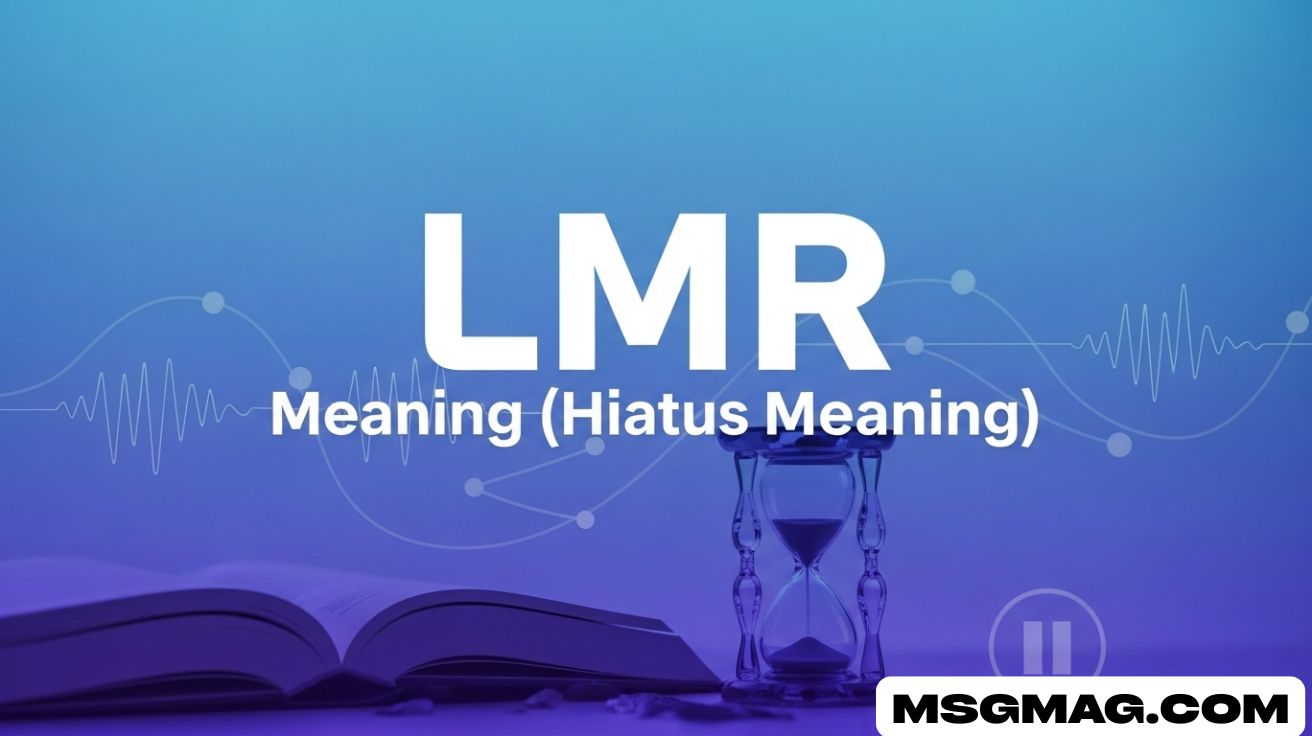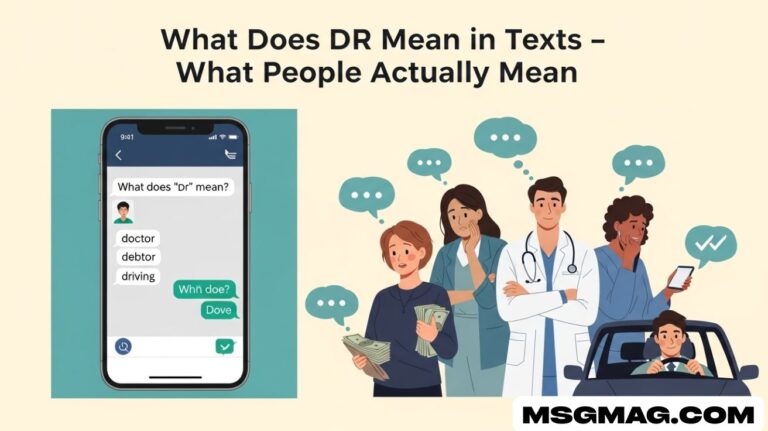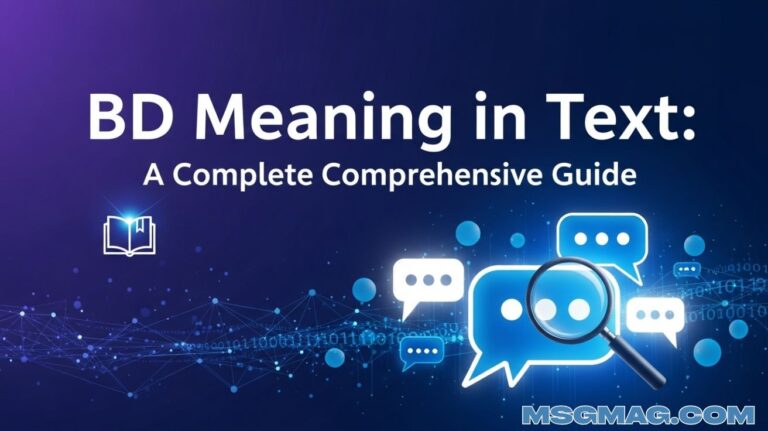LMR Meaning (Hiatus Meaning): Complete Guide for Texting
LMR Meaning is a popular texting term. It usually stands for “Last Message Received”. Sometimes, it also means “Let Me Respond.” People use it to show they saw a message or will reply soon.
Many people get confused by LMR in chats. It looks strange at first. But knowing its meaning helps avoid misunderstandings. Using it correctly keeps conversations smooth.
LMR Meaning is common in social media and texting apps. It is mostly informal. Using LMR abbreviation shows quick acknowledgment. It is a simple way to respond without writing long messages.
1. What Is LMR? Definitions & Contexts
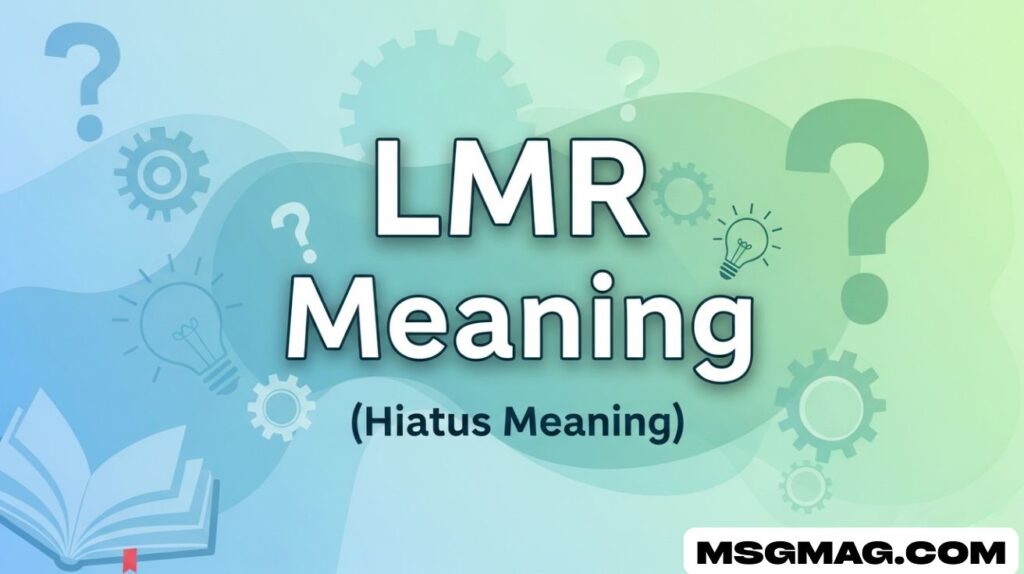
A. LMR in Social/Text Language
LMR meaning is primarily used as a texting acronym among friends or peers. The most common meaning is Last Message Received, which indicates that a person has seen your message but has not yet replied. Sometimes, it can also mean Let Me Respond, signaling that the person intends to reply but needs a moment to gather their thoughts. In the context of casual text abbreviations and digital shorthand usage, understanding these subtleties is important. People often use LMR abbreviation in platforms like WhatsApp, Instagram, or Messenger to acknowledge a message without committing to an immediate response. This small gesture can prevent misunderstandings, especially when dealing with response delays in texts.
B. LMR in Specific Industries
Although LMR meaning is widely known in texting, it also has meanings in professional and technical settings. For example, in telecommunications, LMR can stand for Land Mobile Radio, a system used for wireless communication in public safety or commercial services. In business contexts, it can mean Logistics Metrics Reporting, appearing in reports or dashboards. In AI-related discussions, some might refer to Language Model Response as LMR. While these uses are important in specialized fields, they are usually irrelevant for everyday casual texting. Understanding the difference between informal texting acronyms and industry-specific abbreviations ensures that your messages are interpreted correctly.
C. How to Interpret “LMR” in Conversation
Using LMR in a conversation usually signals acknowledgment while hinting at a slight delay. It is a polite way to communicate that you’ve seen a message without replying immediately. In terms of messaging etiquette, it shows that the sender intends to engage further. For example, if a friend asks for a photo, replying with “LMR” signals, “I’ve got your message, I’ll handle it soon.” This practice is common in social media shorthand where brevity is valued, but tone and context matter.
D. When to Use (And Avoid) LMR
LMR abbreviation is best used among friends or in informal settings. Using it in formal emails or professional communications can appear too casual or even careless. If you are in a workplace setting, it is better to write full phrases like “Message received,” “Noted,” or “I’ll get back to you.” These alternatives maintain professionalism while still acknowledging the message acknowledgment. Understanding the difference between informal vs formal text usage helps avoid awkward situations and misinterpretations.
2. What Does “Hiatus” Mean?
A. Basic Definition
A hiatus is a pause or break in activity, often used in professional, personal, or creative contexts. Its hiatus meaning can vary slightly depending on context, but it always refers to a temporary interruption. Common synonyms include rest, interval, gap, or break. Whether it’s taking a work hiatus to recharge or a personal hiatus from social media, understanding the nuances is crucial for clear communication.
B. Origins & Usage
The word hiatus originates from the Latin word “hiatum,” which means “opening” or “gap.” Over time, it became widely used in English to signify a pause or break in activity. It is commonly used in professional writing and casual conversation alike. Television shows might be “on hiatus” between seasons, an artist could take a hiatus between albums, and individuals might take a personal hiatus from work or social media to focus on mental health. The hiatus definition remains neutral and does not imply negativity, making it suitable in both professional and informal contexts.
C. How to Use “Hiatus” Properly
Using the term hiatus requires attention to tone, length, and context. In professional writing, it communicates a deliberate pause or rest period. The break can be short, like a few days, or long, such as several months. The tone of hiatus is generally neutral; it does not convey failure or avoidance. In casual texts, saying “I’m on a brief hiatus from social media” is clear and professional-sounding while remaining easy to understand. Using professional messaging phrases alongside “hiatus” can further enhance clarity.
D. Examples of “Hiatus” in Context
Consider these examples of hiatus meaning in different settings. A work context might be: “Our team will take a two-week hiatus to focus on strategy planning.” A casual conversation could be: “I’m taking a short hiatus from Instagram to recharge.” In creative industries, an example would be: “The singer announced an indefinite hiatus from touring.” These examples demonstrate how the word can adapt to various communication tones while signaling a temporary break in activity.
3. Stand For — And Meaning in Text

A. “Stand For”
The phrase “stand for” is used to explain what something represents or supports. Literally, you might say, “RGB stands for Red, Green, Blue.” Figuratively, you could use it in a sentence like, “I stand for equality and fairness.” In professional messaging phrases or formal writing, it’s best to spell out such expressions fully rather than rely on abbreviations or shorthand.
B. The Simple “And”
The word “and” is one of the most common connectors in English. It links words, ideas, or phrases smoothly. In texting, people often replace it with “&” for brevity, which is a form of digital shorthand usage. However, in professional writing, it is better to use the full “and” to maintain clarity and formality.
4. Alternatives to Common Well‑Wishing Phrases
When communicating in English, well-wishing phrases are essential for tone and politeness. Different alternatives work depending on context. For example, “Best wishes” in formal contexts becomes “Please accept my best wishes,” whereas in casual texts, “All the best!” is acceptable. For “Take care,” formal usage could be “Please take care of yourself,” while casual texting may simply say, “Take care, mate!” Similarly, “Good luck” in professional messaging phrases could read,
“Good luck with the presentation tomorrow,” whereas in casual conversation, “Good luck, you’ll smash it!” works perfectly. The phrase “Stay safe” can range from formal, “Please remain safe during your travels,” to casual, “Stay safe out there!” Choosing the right phrase requires understanding messaging etiquette, communication tone, and informal vs formal text usage.
5. Tone, Context & Choosing the Right Alternative
Choosing the right alternative depends heavily on tone, audience, and medium. For instance, informal text abbreviations like LMR are suitable among peers, but formal messages should avoid them. In professional emails, polite alternatives like “Noted” or “I’ll respond shortly” convey respect and acknowledgment. Cultural and regional differences also influence how phrases are perceived.
For example, Americans tend to prefer concise well-wishing phrases in emails, while longer, formal phrases may be common in other English-speaking countries. In any situation, leaning slightly more formal is safer because it maintains politeness and reduces the risk of being misinterpreted.
6. Eleven Polished Examples
To illustrate proper usage, here are examples of formal, professional, and casual phrases incorporating both LMR meaning and hiatus definition. A formal example: “Please accept my heartfelt best wishes as you embark on this next phase. Your dedication has been exemplary.” Professional: “Wishing you every success with the project launch next month—LMR, I’ll review the report soon.” Casual:
“All the best for tonight’s game—you’ve got this!” Additional examples include: “Take care and best of luck with the client presentation—you’ll do great,” and “I’m taking a brief hiatus from social media to recharge—LMR when you’re free to chat.” These examples show the nuanced differences in communication tone, response expectations, and appropriate digital shorthand usage.
7. Tone Nuances & Usage Guidelines
Understanding tone nuances is essential for effective messaging. A table can clarify common phrases:
| Phrase | Tone | Best For |
| Please accept my best wishes | Formal | Official letters, VIP emails |
| Wishing you success | Professional | Work emails, colleagues |
| All the best! | Casual | Friends, informal emails |
| Take care and stay well | Professional | Colleagues, remote teams |
| Stay safe out there | Casual | Friends, travel communication |
The table demonstrates how slight differences in wording and context influence messaging etiquette and perceived professionalism.
8. Using “LMR” and “Hiatus” in Text Conversations
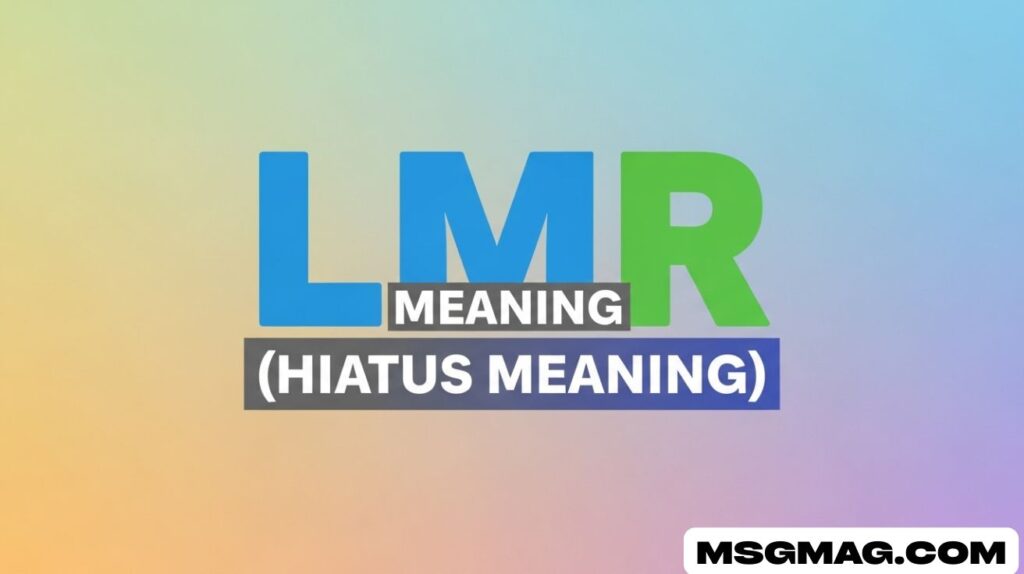
Here are real-life examples for context. A friend asks, “Can you send the photos from last weekend?” A casual reply might be, “LMR—got them now, uploading!” In a professional setting, using LMR is discouraged; instead, write, “Noted—I’ll respond shortly.” For hiatus, a colleague may say, “We’re taking a brief hiatus from meetings next week to recharge.” In casual conversation, it could be: “I’m on a short hiatus from Instagram for a few days.” These examples demonstrate the correct application of LMR meaning, hiatus meaning, and polite alternatives in texting while maintaining appropriate communication tone.
9. SEO & Google‑Optimized Writing Tips
For content to rank well on Google, it is essential to use natural language and avoid keyword stuffing. Incorporate synonyms like pause, break, rest period, or interval. Keep paragraphs concise, structured with headings, and include real-life examples for clarity. Internal links to related topics such as other texting acronyms, social media shorthand, or professional messaging guides improve SEO and user experience. Using casual text abbreviations naturally alongside formal explanations ensures the content appeals to a broad audience.
Understanding LMR in Modern Texting
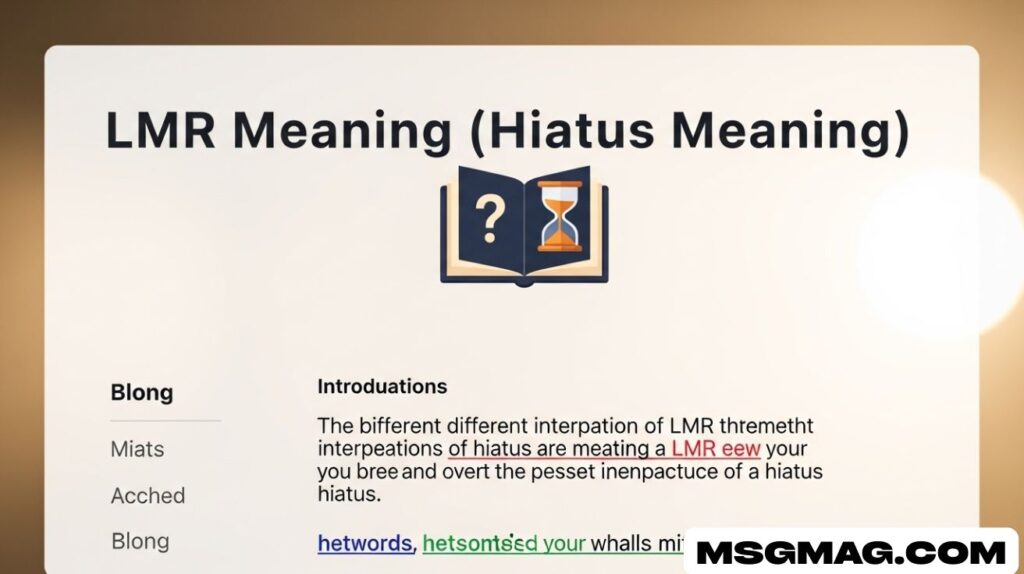
LMR meaning has become a common part of texting acronyms in everyday messaging. It usually stands for Last Message Received, letting someone know that their message has been seen. People also use it as Let Me Respond to indicate they will reply later. This shorthand helps maintain quick communication without leaving the sender anxious or ignored.
Using LMR abbreviation correctly requires understanding context. In casual conversations, it signals engagement, while in professional texts, it may seem too informal. Knowing the proper setting for digital shorthand usage ensures your message is interpreted as intended. It also reflects messaging etiquette, especially when dealing with response delays in texts among peers or colleagues.
Hiatus: More Than Just a Break
The hiatus definition refers to a temporary pause or break in activity, whether in work, personal life, or creative projects. Common examples include TV shows on hiatus, employees taking a short leave, or musicians pausing their tours. Understanding the hiatus meaning helps in communicating clearly, indicating rest without implying failure or disengagement.
A hiatus can be short or long, personal or professional. Using it properly in messages shows awareness of communication tone and timing. Explaining a break clearly, whether in casual texts or formal emails, reflects good messaging etiquette and prevents misunderstandings. It also provides a structured way to announce pauses to audiences, colleagues, or friends.
Read Also : OMY Meaning: What It Means in Text and Chat
Polite Alternatives to LMR in Professional Settings
While LMR abbreviation works in casual texts, professional messages require more formal phrasing. Instead of writing “LMR,” alternatives like “Message received,” “Noted,” or “I’ll respond shortly” convey acknowledgment respectfully. These professional messaging phrases maintain clarity and respect, demonstrating that you value both time and communication etiquette in a workplace setting.
Choosing polite alternatives also ensures your informal vs formal text balance is correct. Using full sentences instead of digital shorthand usage avoids confusion and conveys a professional tone. This approach improves workflow, reduces misunderstandings, and strengthens professional relationships, making communication both efficient and courteous in emails, reports, or team chats.
Balancing Casual and Formal Messaging
Modern messaging requires balancing casual text abbreviations with formal expressions depending on the audience. Informal platforms like Instagram or WhatsApp favor LMR meaning, while emails or business tools demand complete sentences and professional messaging phrases. Understanding this difference ensures your communication tone matches the context.
Overusing casual acronyms in formal settings can appear careless. Meanwhile, overly formal messages in casual chats may seem stiff. Mastering the mix of messaging etiquette, digital shorthand usage, and timing for response helps maintain smooth, effective communication across friends, colleagues, and social networks without misinterpretation.
Recognizing Hiatus in Personal and Work Life
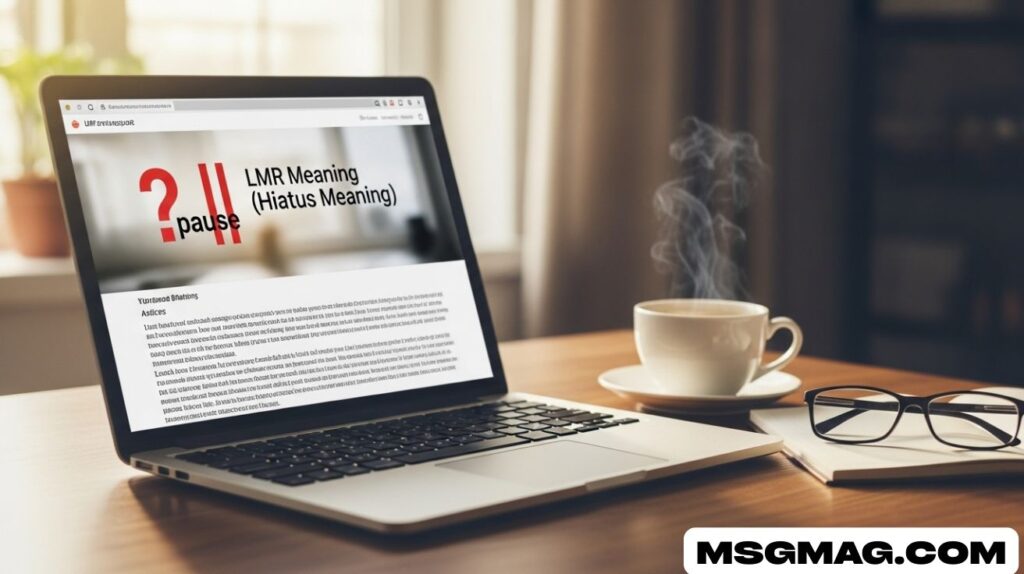
A hiatus isn’t just a professional term; it also applies to personal life. People often take personal hiatus from social media, hobbies, or daily routines to recharge. Recognizing these pauses allows friends, family, and coworkers to respect boundaries while understanding the pause or break in activity is temporary.
In a work setting, a work hiatus might involve stepping back from projects, meetings, or emails to focus on priorities. Clearly communicating this break using the hiatus definition and proper messaging etiquette prevents confusion, ensures team coordination, and maintains trust while supporting personal well-being and professional efficiency.
Enhancing Text Clarity with Tone and Context
Understanding communication tone is crucial when using acronyms like LMR or words like hiatus. Tone informs whether your message appears casual, polite, or professional. Clear messaging reduces misinterpretation, especially when response delays in texts might otherwise cause concern or frustration in both personal and professional interactions.
Context also guides appropriate digital shorthand usage. Knowing when to use texting acronyms, formal phrases, or polite alternatives in texting ensures your audience interprets the intended meaning. Proper tone and context strengthen relationships, convey respect, and enhance overall communication, whether in casual chats, social media, or professional correspondence.
FAQs
What does LMR mean in texts?
LMR usually means “Last Message Received” or sometimes “Let Me Respond” in texting.
Is LMR used in texting?
Yes, LMR abbreviation is commonly used in casual texting to acknowledge messages or indicate a delayed reply.
What does LMR stand for in a relationship?
In relationships, LMR often signals “Last Message Received”, showing awareness of a partner’s message without immediate response.
Why does LMR stand for?
LMR stands for “Last Message Received” or “Let Me Respond”, used to indicate acknowledgment or intention to reply.
Conclusion
Understanding LMR meaning and the hiatus definition can transform the way you communicate both digitally and professionally. Knowing when to use casual texting acronyms, professional messaging phrases, and polite alternatives ensures your tone is appropriate and clear.
By practicing the examples and guidelines in this article, you can confidently navigate informal vs formal text, acknowledge messages properly, and communicate with both friends and colleagues effectively.

